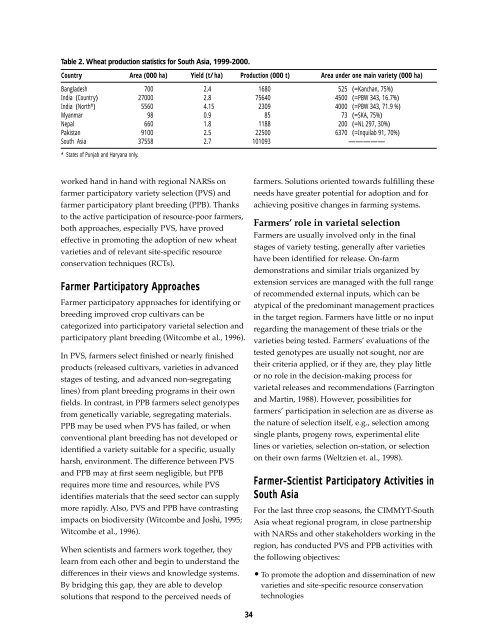Research Highlights of the CIMMYT Wheat Program 1999-2000
Research Highlights of the CIMMYT Wheat Program 1999-2000
Research Highlights of the CIMMYT Wheat Program 1999-2000
You also want an ePaper? Increase the reach of your titles
YUMPU automatically turns print PDFs into web optimized ePapers that Google loves.
Table 2. <strong>Wheat</strong> production statistics for South Asia, <strong>1999</strong>-<strong>2000</strong>.<br />
Country Area (000 ha) Yield (t/ha) Production (000 t) Area under one main variety (000 ha)<br />
Bangladesh 700 2.4 1680 525 (=Kanchan, 75%)<br />
India (Country) 27000 2.8 75640 4500 (=PBW 343, 16.7%)<br />
India (North*) 5560 4.15 2309 4000 (=PBW 343, 71.9 %)<br />
Myanmar 98 0.9 85 73 (=SKA, 75%)<br />
Nepal 660 1.8 1188 200 (=NL 297, 30%)<br />
Pakistan 9100 2.5 22500 6370 (=Inquilab 91, 70%)<br />
South Asia 37558 2.7 101093 —————<br />
* States <strong>of</strong> Punjab and Haryana only.<br />
worked hand in hand with regional NARSs on<br />
farmer participatory variety selection (PVS) and<br />
farmer participatory plant breeding (PPB). Thanks<br />
to <strong>the</strong> active participation <strong>of</strong> resource-poor farmers,<br />
both approaches, especially PVS, have proved<br />
effective in promoting <strong>the</strong> adoption <strong>of</strong> new wheat<br />
varieties and <strong>of</strong> relevant site-specific resource<br />
conservation techniques (RCTs).<br />
Farmer Participatory Approaches<br />
Farmer participatory approaches for identifying or<br />
breeding improved crop cultivars can be<br />
categorized into participatory varietal selection and<br />
participatory plant breeding (Witcombe et al., 1996).<br />
In PVS, farmers select finished or nearly finished<br />
products (released cultivars, varieties in advanced<br />
stages <strong>of</strong> testing, and advanced non-segregating<br />
lines) from plant breeding programs in <strong>the</strong>ir own<br />
fields. In contrast, in PPB farmers select genotypes<br />
from genetically variable, segregating materials.<br />
PPB may be used when PVS has failed, or when<br />
conventional plant breeding has not developed or<br />
identified a variety suitable for a specific, usually<br />
harsh, environment. The difference between PVS<br />
and PPB may at first seem negligible, but PPB<br />
requires more time and resources, while PVS<br />
identifies materials that <strong>the</strong> seed sector can supply<br />
more rapidly. Also, PVS and PPB have contrasting<br />
impacts on biodiversity (Witcombe and Joshi, 1995;<br />
Witcombe et al., 1996).<br />
When scientists and farmers work toge<strong>the</strong>r, <strong>the</strong>y<br />
learn from each o<strong>the</strong>r and begin to understand <strong>the</strong><br />
differences in <strong>the</strong>ir views and knowledge systems.<br />
By bridging this gap, <strong>the</strong>y are able to develop<br />
solutions that respond to <strong>the</strong> perceived needs <strong>of</strong><br />
farmers. Solutions oriented towards fulfilling <strong>the</strong>se<br />
needs have greater potential for adoption and for<br />
achieving positive changes in farming systems.<br />
Farmers’ role in varietal selection<br />
Farmers are usually involved only in <strong>the</strong> final<br />
stages <strong>of</strong> variety testing, generally after varieties<br />
have been identified for release. On-farm<br />
demonstrations and similar trials organized by<br />
extension services are managed with <strong>the</strong> full range<br />
<strong>of</strong> recommended external inputs, which can be<br />
atypical <strong>of</strong> <strong>the</strong> predominant management practices<br />
in <strong>the</strong> target region. Farmers have little or no input<br />
regarding <strong>the</strong> management <strong>of</strong> <strong>the</strong>se trials or <strong>the</strong><br />
varieties being tested. Farmers’ evaluations <strong>of</strong> <strong>the</strong><br />
tested genotypes are usually not sought, nor are<br />
<strong>the</strong>ir criteria applied, or if <strong>the</strong>y are, <strong>the</strong>y play little<br />
or no role in <strong>the</strong> decision-making process for<br />
varietal releases and recommendations (Farrington<br />
and Martin, 1988). However, possibilities for<br />
farmers’ participation in selection are as diverse as<br />
<strong>the</strong> nature <strong>of</strong> selection itself, e.g., selection among<br />
single plants, progeny rows, experimental elite<br />
lines or varieties, selection on-station, or selection<br />
on <strong>the</strong>ir own farms (Weltzien et. al., 1998).<br />
Farmer-Scientist Participatory Activities in<br />
South Asia<br />
For <strong>the</strong> last three crop seasons, <strong>the</strong> <strong>CIMMYT</strong>-South<br />
Asia wheat regional program, in close partnership<br />
with NARSs and o<strong>the</strong>r stakeholders working in <strong>the</strong><br />
region, has conducted PVS and PPB activities with<br />
<strong>the</strong> following objectives:<br />
• To promote <strong>the</strong> adoption and dissemination <strong>of</strong> new<br />
varieties and site-specific resource conservation<br />
technologies<br />
34

















